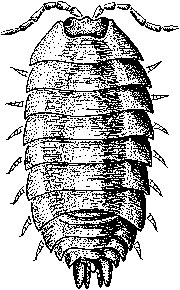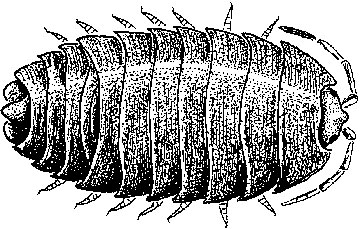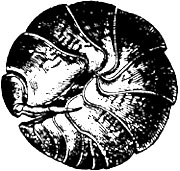Contrary to their name, sowbugs and pillbugs belong in the class Crustacea. Thus, they are more closely related to shrimp, crabs and lobsters than insects. These isopods are native to Europe but have been introduced throughout the world. Although they may occasionally invade the home, they normally prefer moist areas outdoors at the soil surface in mulched flowerbeds, leaf litter, grass clippings and other debris around foundations. However, cracks between slabs and porches and in basement walls provide excellent hiding places from which these occasional invaders can enter homes. These pests do not pose an economic or health threat to humans, but some sowbugs occasionally damage roots, fruits, vegetables, or the tender stems of plants. Annoyance from the presence of these invaders inside the home is the main concern with this group of pests.
Biology
Pillbugs and sowbugs typically overwinter in the adult stage. Typically, this overwintering occurs in areas in which microclimates are favorable (i.e.: heated buildings, urban woodlands). In the spring, the isopods will emerge and begin mating.

In some species of sowbugs and pillbugs, female carry the eggs within a pouch called a marsupium. Females typically lay one to two broods a year, each of which can contain a few dozen eggs. After emergence, nymphs (mancas) are similar in appearance to adults. However, they are missing one pair of walking legs (pereiopods), are smaller in size, and are paler in coloration. These nymphs take about a year to fully develop into adults.
Sowbug
Sowbugs (Family: Porcellionidae) are light gray to slate-colored, with slightly elongated bodies that can reach 1/2 inch in length (Figure 1). The body is distinctly segmented. Sowbugs have seven pairs of legs, two pairs of antennae and two prominent tail-like appendages. Sowbugs are also unique from pillbugs as they cannot roll into a ball.
Female sowbugs retain eggs in a brood pouch for three to four weeks until they hatch. After hatching, the young remain in the pouch for up to a month. These newly hatched sowbugs resemble the adults except in size. Each female can produce broods of 25 to 75 young several times a year. They are nocturnal in habit, due to their susceptibility to desiccation.
Pillbug


Pillbugs (Family: Armadilidiidae) are dark gray to black and are not as flat as sowbugs (Figure 2a). The body is distinctly segmented with seven pairs of legs and two pairs of antennae. The abdomen has no tail-like appendages. Unlike sowbugs, pillbugs can roll into a tight ball when disturbed (Figure 2b). This response makes them easy to distinguish from sowbugs and has earned them the nickname "roly-poly." This behavior is both defensive and serves to retain water. The reproductive biology of pillbugs and sowbugs is similar. The eggs are deposited and hatch within a brood pouch, where they stay for up to 45 days before emerging.Pillbugs are nocturnal and remain inactive and hidden under objects during the day to reduce water loss. Avoiding water loss is important for them because they lack an outer waxy layer and cannot close their respiratory system. This leads to dehydration at low humidities.
As pests
Sowbugs and pillbugs will enter the basement and first floor of a home through cracks and crevices in the foundation and walls. Their presence indoors is a good sign that considerable numbers are present in the soil outside. These pests are very dependent on moisture, and unless there is an unusual moisture problem, these organisms do not survive indoors for longer than a few days.
Management
Sanitation is the first step in managing infestations of sowbugs and pillbugs. Remove vegetation and other organic matter such as rotting wood or clippings from the soil surface around the foundation of your home. Minimize watering near the foundation as well. Removing debris and moisture will reduce the likelihood that sowbugs, pillbugs, millipedes and centipedes will enter the home. A program of continued sanitation close to the building, such as cleaning up or removing piles of rocks, boards, leaves, compost, and general refuse, will help reduce populations of these pests.
Check the basement, foundation, and first-floor entrances for cracks and crevices and use caulking or other filling materials to minimize the number of entry points around doors, basement windows and other openings. In addition, reduce water seepage and ventilation problems so that damp hiding places are eliminated.
Outdoor management
Pesticides may be used in areas where sowbugs and pillbugs are found despite sanitary measures. To reduce migrations into homes, treat the outside foundation and adjacent ground in a strip about three feet wide with a dust or aerosol spray that is labeled for these pests. Read the label and follow all label directions when using pesticides. If the label does not include sowbugs and pillbugs, it should not be used to manage these pests.
For homes in or near wooded areas that contain large amounts of organic matter and moisture, it may be necessary to treat a strip around lawn edges and adjacent to the woods. A dust or granule formulation is best in this case. Reapplication may be necessary after a heavy rain.
Indoor management
In cases where sowbug and pillbug invasions are not solved by outdoor management strategies, you may choose to apply pesticides to selected interior basement or ground floor areas. In these situations, it is desirable to use targeted applications of pesticide to areas where the pests are likely to occur, rather than indiscriminately treating large areas. Areas where targeted applications are beneficial for these pests are points of entry from outdoors. These areas include windowsills, doorsills and casings and the junction of walls and floors.
Direct application of a household aerosol spray containing pyrethrins or any of the pyrethroids may also be needed to control occasional sowbugs and pillbugs. To avoid spotting or staining of finished surfaces, obtain ready-to-use household formulations that are available at hardware stores, lawn and garden centers, or other reputable merchants.
Warning
- Apply chemicals only where needed or justified.
- Before using any chemical, please read the label carefully for directions on application procedures, appropriate rate, first aid, storage, and disposal.
- Make sure that the chemical is properly registered for use on the intended pest and follow all other label directions.
- Keep insecticides in original containers, complete with labels, and keep them out of the reach of children and pets.
- Do not allow children or pets near treated areas before these areas dry.
- Carefully and properly dispose of unused portions of diluted sprays and empty insecticide containers.
Caution
When using aerosol formulations of pesticides, do not allow small children or pets access to the treated areas until they have completely dried. When using dusts or granule formulations, keep children and pets out of treated areas following rain or watering.
As pets
Common pet species include:
- Powder orange (Porcellionides pruinosus)
- Dairy cow (Porcellio laevis)
- Zebra (Armadillidium maculatum)
- Clown (Armadillium klugii)
Additionally, native species can be caught around your home and kept as pets as well. These isopods require plant matter and moist soil. It is critical to ensure that prospective pet owners research species requirements for individual species before purchasing new pets.
